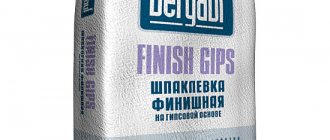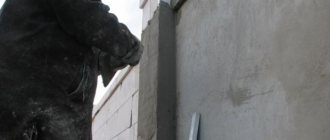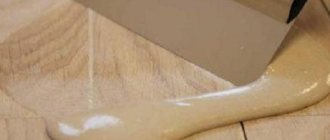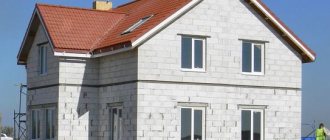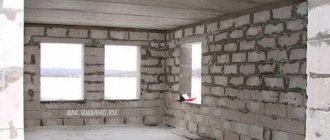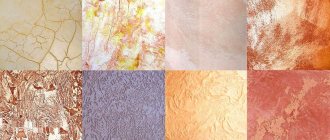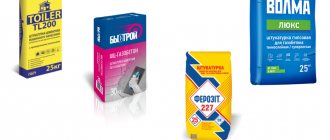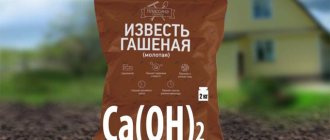From this article you will learn:
- How to start leveling walls for wallpaper
- How to choose the right putty mixture for leveling walls under wallpaper
- How to level walls with wallpaper using putty
- How to properly level walls for wallpaper using plaster
- Why is the method of leveling walls under wallpaper using drywall so popular?
- How to carefully seal seams between sheets of drywall
- Is it possible to use glue to attach drywall sheets when leveling walls under wallpaper?
- What wallpaper to put on flat walls
Smooth walls play a big role in the overall impression of the interior of the room. Often the walls in old houses are crooked and lumpy, and even in new buildings they are far from ideal. Leveling the walls will allow you to hide defects and get a smooth surface, and this must be done before gluing wallpaper, because the final result of the repair depends on the quality of the wall surface. You will learn how to level walls for wallpaper in our article.
Where to start leveling walls for wallpaper
Wallpaper is an ideal option for decorating the walls of residential premises, so traditionally most owners of houses and apartments in Moscow choose them. This material is sensitive to unevenness, which means that the wall surface must be leveled before cladding. If you leave even slight roughness, the appearance of the room can be ruined, especially if you choose thin wallpaper as the material for covering the walls.
The procedure for preparing to level the walls for wallpaper:
- The wall surface is cleaned of all protruding elements; if the base is brick, it is necessary to unstitch the seams.
- Dust, dirt, remnants of old wallpaper or plaster are removed.
- The walls are impregnated with a primer, the composition of which is selected depending on the surface material. The primer is applied in at least two layers, this will increase the adhesion of the wall surface.
- The primer usually already contains an antifungal element, but it will be better if the wall is treated with a special antifungal solution before priming.
The choice of materials and tools for work mainly depends on:
- the degree of damage to the walls, their condition in general;
- the amount of material costs required to put the wall surface in order;
- the time it will take to carry out all the work to level the surface of the wall.
In order to decide on the means for leveling walls for wallpaper or painting, you can consult with an experienced master builder or a specialist in a store. The choice of materials depends on the characteristics of the walls and the quality of their surface.
The primer can be different; it may contain resin, bitumen, lime, and oils. The purpose of the primer is to prepare the surface for applying putty or other material intended for filling uneven areas. The primer increases the degree of surface adhesion, that is, its ability to hold putty or other finishing material on itself.
Types of putties
Puttying walls for painting with your own hands
Before buying a material, you need to know its types and what each of them is needed for. And which putty is best for painting walls in your home. Depending on the composition of the base, there are the following types:
- Cement - often used for filling external walls - facade, balcony. But sometimes they are used in rooms. It is also moisture resistant, so it can be used for interiors in the bathroom and kitchen. It does not have elasticity, and because of this, micro cracks sometimes appear. Used for puttying external and internal concrete walls for painting. The price is low.
- Polymer is the most modern, and therefore expensive. Puttying with this type of material can be done easily and quickly. Elastic, does not settle, any paint can be applied well.
- Gypsum - used for internal putties, fire-resistant and dries quickly. Perfectly seals seams and cracks between concrete and gypsum boards. Not moisture resistant, so should not be used in the bathroom. Low cost.
Important! After determining the desired type, you can choose a manufacturer with good quality and inexpensive cost. On average, consumption is 0.5 kg of mixture per 1 m2.
Putty mixtures for leveling walls under wallpaper
There are 4 main types of putty: gypsum, lime, cement and polymer. The selection of its composition is carried out according to the intended purpose of the room, as well as for the finishing coating of the walls, for example, for wallpapering.
Learn more about each type of putty.
- Gypsum putty. A universal mixture that can be the basis for any wall finishing materials, including wallpaper. But this type of putty has a serious drawback: it cannot be used as a base on the walls of rooms with high humidity, for example in a bathroom, toilet or kitchen. Gypsum putty can be applied in a layer of more than 2 millimeters; the material practically does not shrink.
- Polymer putty. A universal material suitable as a base for any finishing materials. Does not shrink and can be applied even in a thin layer. The disadvantages include the high cost, as well as the risk of buying low-quality and even counterfeit goods. But this putty is not afraid of temperature changes.
- Cement putty. The material is inexpensive and can be used in damp areas. But due to weak elasticity and a high degree of shrinkage, cement putty often cracks, so it must be applied in two layers. The material has a long hardening time, but is suitable for any finishing coating.
- Lime putty. It is a mixture of lime particles with cement particles, therefore it has all the advantages and disadvantages of cement putty. This type of material is used for finishing the facades of buildings and walls that were previously plastered with lime mixtures. Finishing with lime putty is perfect for painting walls with various paints, including lime paints.
Take the test
Leveling walls with wallpaper putty
The classic option for finishing walls before wallpapering is to use putty. This is how most surfaces are prepared for subsequent wallpapering.
There are two types of putty sold in stores: dry mixtures and a ready-made solution. If you purchase a dry mixture, it is diluted with water yourself. Usually the manufacturer indicates on the container in what ratio the dry mixture and liquid should be mixed in order to obtain a putty with optimal parameters.
The type of putty used depends on the wall material, surface condition and finishing coat. An important role in choosing a leveling mixture is played by the purpose of the room, the temperature regime, as well as the air humidity in it.
There is no fundamental difference between dry putties and ready-made solutions. The only difference is the need to dilute the dry mixture yourself. Ready-made putty solutions are usually considered to be of higher quality, since the manufacturer, in industrial conditions, maintains the ratio of dry material and water most accurately.
Selecting putty is a responsible matter; there are several types: starting, finishing and universal. Each of them is designed to perform one or another finish.
Starter putties are used to smooth out deep cracks and unevenness on the wall surface. Such compositions can be applied in a thick layer of 10 to 30 millimeters, and the material does not have a tendency to crack.
Finishing putties are intended for final leveling of walls under wallpaper; they can be applied in a layer of up to 10 millimeters. The structure of this type of material is fine-grained, which makes the finished surface smoother.
Universal putties have the strength of starting putties, do not crack, and at the same time can be used as final putties, since they have a fine-grained structure.
Classification of mixtures
When determining which putty is best suited for walls to be painted, developers take into account a number of factors:
- probable shrinkage;
- adhesion index;
- drying speed;
- the presence of various impurities;
- speed of grinding.
The type of wall surface plays an important role.
Cement-based compositions
This material is considered reliable and strong, perfect for any base. The cement-based mixture can withstand the negative effects of a humid environment and temperature changes. This putty has a long service life and is used not only for interior decoration, but also for facade repairs.
In addition to cement, gypsum or lime are added to the composition. The first type of material accelerates the drying of the surface, reducing the time of repair work; thanks to the second component, the plasticity index increases.
The main advantages of cement putty are ease of application, resistance to moisture and frost, and reasonable cost. The disadvantage is the coarse grain structure.
Gypsum mixtures
This group of solutions is divided into starting, finishing and universal materials.
Working with such a composition requires the necessary skills, because the mixture sets quickly.
Putty is used to finish interior walls; it is easy to seal joints and cracks and eliminate minor defects. The material is considered environmentally friendly, guarantees reliable adhesion, is used economically, has an affordable price, and is easy to sand.
Unfortunately, the solution sets quickly and is not used for facade finishing. In addition, the gypsum mixture has poor contact with concrete walls; puttying rooms with high humidity levels with such material is prohibited.
Polymer putties
The compositions are sold in a state prepared for application, which is very convenient when finishing walls. The mixtures have an acrylic or latex base and form an even and dense coating.
They perfectly resist the influence of negative external factors and are resistant to mechanical damage, which gives every reason to putty external walls with them for painting. The applied layer is not susceptible to exposure to water, does not wear out, does not shrink, and is easy to sand.
Due to the fine-grained structure, the solution eliminates almost any flaws, has good elasticity, resists sudden changes in temperature, is economical and dries quickly, creates a thermal insulating layer and does not pose a danger to the human body.
Unfortunately, mixtures of this group are characterized by high prices. Coatings applied in a thick layer become covered with cracks and have low vapor permeability.
How to apply putty to level walls under wallpaper
The basic rule for filling walls is careful application and leveling. To work, you will need a spatula, usually a synthetic cord and a building level.
Each master uses his own technique for applying putty to the wall. Some people use a wide spatula, while others find it more convenient to use a small tool.
The work of leveling walls under wallpaper with your own hands is not difficult, the main thing is to be careful and try to evenly distribute the putty over the surface of the wall, removing even the smallest irregularities.
In some cases, the putty composition is applied in several layers, with a reinforcing mesh placed between each layer to prevent cracking of the surface.
The starting and finishing layers are usually placed perpendicular to each other, which makes it possible to make the wall surface as even as possible.
The finishing layer is made as thin as possible; after drying, it is covered with a primer composition. The final step is to level the walls with a special sandpaper of suitable grain size.
When the putty applied to the wall has completely dried and is leveled with sandpaper, the surface is treated with a finishing layer of primer.
How to putty correctly
Return to contents
Puttying under wallpaper
It is not difficult to putty walls under wallpaper. Putty is put on a spatula and stretched over a certain area. But in order for the work to be carried out efficiently, you need to follow the recommendations.
Scheme of grouting joints with a spatula.
- The wall must be cleared of grains of sand.
- The surface is primed. As a result, a dense crust forms on the wall, which also improves adhesion.
- The putty is applied after the primer has dried. The thickness of the leveling layers should not exceed 2 mm, otherwise when drying the coating may crack and crumble.
- Start putting putty from one of the corners of the wall. Start leveling from the bottom.
- Apply putty to all corners of the wall. You can use an angle spatula. The mixture is not applied to it, but using a syringe gun directly into the corner. The spatula only smoothes it out.
- After finishing the corners, start working on the main surface.
- Apply the mixture onto a spatula in small portions. For now, use a narrow tool. Once you get better at it, you can use a wider spatula. Remember that a wide tool will level a large area, but it will be somewhat harder to work with it due to the increase in the mass of the mixture.
- Work with 2 spatulas. Apply the narrower putty to the main one. In addition, with the second spatula you can adjust the amount of mixture on the first one, remove excess from the spatula, move the putty towards the edge, etc.
- The putty is applied in diagonal movements. Each subsequent portion of the leveler is overlapped with the previous one.
- After the first layer has dried, which lasts at least ½ day, the surface is sanded with a special abrasive mesh attached to a block or jointer, since the edges of the spatula leave marks on the wall in the form of grooves and sagging.
- The wall is primed again.
- The putty is applied one more time. This is done only to correct the remaining unevenness, and not to create another layer.
- The surface is cleaned again. Dust is removed from it. The walls are primed, but only for wallpapering.
Return to contents
Leveling for painting
List of basic tools for puttying walls and ceilings.
Still, wallpaper is less demanding on the condition of the surface than paint. The walls under it should be finished with greater care. True, water-based coatings are to some extent capable of hiding minor surface imperfections, while enamels, on the contrary, will stick them out. Therefore, puttying for painting is carried out with a large number of leveling layers, with a spatula of smaller width, and sanding is carried out with a thinner abrasive.
Related article: Artificial stone for interior wall decoration
It should be noted that defects may remain invisible or, conversely, appear at different lighting angles, so sanding of each layer should be carried out under the light of a lamp brought close to the surface. There is another way to determine how correctly the plane is formed: a rule is set on it, and a flashlight is turned on on the opposite side near it. All surface curves will be clearly visible. Excess putty is removed with sandpaper or a spatula, and the depressions are outlined with a pencil. After this, the unevenness is sealed with a leveling mixture, and a new layer of putty is applied.
Return to contents
What is needed to level walls under wallpaper with plaster
Plaster is a universal material, thanks to which you can eliminate almost any defects on the walls. How to level walls for wallpaper using plaster and is it worth choosing this particular material, since working with it is more difficult than with ordinary putty? Repair experts admit that plaster gives a better result than putty, although it takes longer to achieve it with the former.
Today you can see many types of plaster on the shelves of construction stores; how can you avoid making a mistake and choose the most suitable one for leveling concrete walls for wallpapering?
There are two main types of plaster.
Cement based plaster
A universal mixture suitable for leveling any walls. It is worth considering that cement-based plaster is divided into two types. Rough plaster contains large particles of sand and is suitable as a base for subsequent leveling of walls. Finish plaster is used for the finishing layer. However, a layer of putty must still be applied on top of the plaster, especially if the surface of the walls is to be painted in the future.
The cement mixture has the following advantages:
- Low cost . Cement-based plaster is inexpensive and therefore has a stable demand.
- Durability. If you follow the technology of applying plaster to the wall surface, the material will last for decades.
- Quick preparation of the solution and ease of application. This feature of the material allows not only professional craftsmen to level the walls for wallpaper, but also beginners who decide to do the work themselves. In addition, cement plaster takes a relatively long time to set, which is also beneficial for beginners.
Recommended articles on this topic:
- Arrangement of a small apartment
- Stages of renovation in an apartment
- Turnkey cosmetic repairs
To impart plasticity to cement plaster and increase antifungal properties, lime is added to the solution. Previously, lime itself was used as plaster, but today this material no longer meets the high requirements and standards of the construction industry.
Cement plaster also has disadvantages:
- One layer of material cannot be thicker than 1.5-2.5 centimeters, as there is a high risk of cracking. Therefore, if necessary, use a reinforcing mesh and apply the composition to the wall in stages.
- Cement plaster takes longer to set, which means repairs will take longer.
- The disadvantages listed above lead to the fact that the labor intensity of leveling walls under wallpaper with cement plaster increases, but sometimes this is the only option suitable for preparing walls in a particular room.
Plaster based on gypsum
A popular option when leveling walls with wallpaper, as it has many positive characteristics:
- Material safety. Gypsum plaster is absolutely harmless to humans and pets, so this material is perfect for lining walls under wallpaper, even in a children's room.
- Excellent moisture absorption. Thanks to this property, plaster made from a gypsum mixture is able to absorb and release excess moisture, maintaining an excellent microclimate in the room.
- Economical. Gypsum plaster is consumed significantly less, so when comparing it with cement plaster, the former turns out to be much more economical, since it will allow you to level a larger area.
The disadvantage of gypsum plaster is its rapid setting. When leveling walls, it is necessary to dilute a small amount of mortar, since excess, which is not applied to the wall for a certain time, will lose its properties.
Sometimes the disadvantage of gypsum plaster is the high cost of the material, but it should be taken into account that the consumption is lower, so the price is compensated by the larger area of wall alignment.
So which plaster is better? There is no clear answer. When leveling walls under wallpaper using plaster, you need to focus on the properties of the surface in each specific case and choose the most suitable material.
Preliminary activities
If you don’t know how to learn how to putty walls for painting, we bring to your attention the procedure for carrying out the necessary work for a wall finished with plaster made from a gypsum mixture.
First of all, the wall surface should be prepared for puttying. Even if a very diligent plasterer worked, small sagging and small debris will remain on the wall. All this will have to be cleaned using a spatula and feeling the wall with your free hand to identify defects. After cleaning, dust is removed from the surface.
The next stage begins - treatment with a primer composition characterized by deep penetration. The mixture is applied with a roller or wide brush; the composition should evenly saturate the wall.
If priming is carried out in a room with high humidity levels, it is recommended to use a mixture containing antiseptic components. It will remove areas of mold and create an obstacle to its subsequent appearance.
The applied primer is given time to dry. Typically this requires at least four hours. How many layers of primer should be applied? Craftsmen recommend treating the wall twice - the first layer will fill the pores and microcracks, and the second will form a film that ensures reliable adhesion and uniform distribution of the putty mixture over the surface.
Leveling walls with plaster under wallpaper
To level the walls for wallpapering, you need to have the following tools on hand:
- building level and rule;
- Master OK;
- spatulas;
- grout grater;
- containers for solution;
- drill with attachment or mixer;
- roulette.
The beacon method is a reliable and long-proven method of leveling surfaces.
The main difficulties can arise only when installing the guides. In general, the beacon method allows you to quickly and with excellent results level large-area walls that have significant shortcomings. Beacons can be fixed using various methods, but most often they are fixed with plaster or cement mortar.
Beacon technology for leveling walls under wallpaper:
- Strictly vertical markings are applied to the wall surface in increments equal to one meter or the length of the rule.
- Special slats with a flat surface are used as beacons.
- The mortar is applied along the edges of the wall and the outer slats are attached to it, it is important that they are aligned with the building level.
- Using a cord stretched between the outer beacons, the remaining slats are set and secured.
- According to the instructions, a mixture is prepared, which should be optimally viscous, plastic and free of lumps.
- The solution is taken with a spatula and thrown onto the wall with a sharp movement. First, the space between the beacons in the lower half of the wall is filled, then a rule is taken and the solution is leveled evenly, with rocking movements from bottom to top.
Over time, the beacons are securely fixed with plaster or cement mortar, and the second stage of leveling the walls for wallpaper begins.
If during such actions any defects are formed, they are filled with plaster solution and leveled.
The second, upper, half of the wall is plastered in the same way, but before this, the border of the lower part is moistened with water so that the solution between the two parts sets and is strong.
As soon as the solution has sufficiently strengthened and adhered to the wall, the beacons are removed and the surface is sanded until the desired result is obtained.
In order for the corners of the room to be even, after plastering the first wall, it is allowed to dry and only after that they begin to level the adjacent wall.
Preparing the tool
If you decide to putty the walls before painting, you will need a certain set of tools:
- roller and brush with which the primer mixture is applied;
- electric drill with mixing attachment;
- a container of a suitable size for mixing the material;
- spatulas with blades of different widths, special angle tools;
- rule;
- building level and plumb line;
- pencil for marking;
- grinder or grater;
- sandpaper;
- putty material;
- primer composition;
- perforated corner;
- lighthouses;
- fiberglass mesh.
What else needs to be done after leveling the walls under the wallpaper with plaster
After leveling the walls, it is necessary to carry out final work.
- Within 12 hours after the plaster has set, the final grouting of problem areas that could have formed due to the removal of the beacons or imperfect work with the rule is carried out.
- For grouting, a trowel or spatula is used; movements are made sharply and in different directions; before grouting, the spatula or trowel is moistened with water.
- Next, in order to finally level the walls for wallpapering, you need to moisten the sponge in water and smooth the surface with gentle movements. It is important to prevent the fresh plaster from getting too wet.
- The final stage of leveling the walls for wallpaper is sanding to obtain a perfectly smooth surface.
Why is plasterboard sheathing so popular for leveling walls under wallpaper?
Drywall is a modern material that allows you to make even the most crooked wall surfaces smooth.
The disadvantage of this method of leveling walls for wallpaper is that it reduces the volume of the room, which is not always acceptable for small rooms.
Advantages:
- Speed. Leveling walls using sheet plasterboard is much faster than using plaster.
- High quality surface. Sheet plasterboard is a smooth material, so no puttying or grouting is required, which saves time and reduces labor costs, and the surface of the walls is smooth and of high quality.
- Significant cost reduction. It is more economical to use sheet plasterboard when it is necessary to level curved walls with deep defects. With a similar surface condition, plaster will cost much more.
- Undemanding to the quality of the base. Drywall can be installed on any permanent wall, regardless of the quality of its surface.
- Minimum amount of wet work. This feature allows you to install drywall after laying the floors.
- The space between the drywall and the wall (of course, when it is mounted on a frame) can be used for laying any communications. For example, electrical wiring, water supply pipes, ventilation pipes, and air conditioning lines may be hidden behind the casing. Also, heat-insulating and sound-proofing material can be laid in the gap between the wall and the drywall.
- The product is environmentally friendly . Drywall can be used in rooms where allergy and asthma sufferers live. It is also allowed to be used in children's rooms and bedrooms.
- Drywall perfectly improves the thermal insulation and sound insulation of rooms. This property allows it to be used in rooms that need to be protected from extraneous noise, such as the bedroom.
Drywall is not without some disadvantages:
- Relatively low strength of the material.
- Inconveniences when attaching hanging furniture, difficulty installing sockets and switches.
- High requirements for vapor permeability of capital walls. If the vapor permeability of the wall and drywall differs, moisture will begin to accumulate in the space between them, which will lead to the destruction of the material, damage to the finish and the formation of fungus.
For rooms with high humidity, such as a bathroom, it is recommended to choose moisture-resistant drywall, which is usually a slightly greenish tint.
For plasterboard cladding you need:
- rule;
- plumb line and building level;
- cord and tape measure;
- knife;
- rubber mallet or mallet;
- glue container;
- construction mixer;
- jigsaw;
- perforator;
- screwdriver
If the level of the wall has a difference greater than 70 millimeters, it will be necessary to install a frame made of special guide profiles.
The frame can be assembled using different profiles, depending on specific conditions.
- If there is a very large difference and curvature of the wall and if it is intended to install large diameter pipes between the wall and the plasterboard, CW rack profiles and UW guides with dimensions of 50 and 75 millimeters are used, depending on the height of the wall and its required rigidity.
- For other options, a CD ceiling profile (60 by 27 mm) and UD guides are sufficient.
In a wooden house, sheets of plasterboard can be secured with simple self-tapping screws directly to the surface of the walls or, in case of serious unevenness, to a special sheathing.
Preparing the surface for painting
The entire painting process can be divided into three steps:
- Cleaning the wall from old plaster or putty coating;
- Leveling and preparing the wall. This stage includes starting and finishing putties;
- Applying paint.
If everything is more or less clear with the first stage, then the second is worth considering in more detail.
The care and patience with which you approach the preparation of the walls will determine the entire result of the repair in the future.
The thing is that preliminary work should make the walls even and smooth, and this directly affects how much the paint layer will settle on the wall.
To understand and understand how to properly putty walls, it is worth learning about different types of putty.
They can be divided into several methods, each of which has some meaning only for a specific situation or purpose.
Starting putty
For this type of putty, gypsum putty is used with the addition of various impurities and additives.
Layers should be applied alternately, with pauses for drying.
A huge plus for the quality of the final result will be the use of a painting mesh, which will significantly reduce the likelihood of cracks.
The starting putty process is used to level concrete or brick walls, as well as to seal unnecessary holes.
Lighthouse variety
It is worth noting that this method of leveling walls is noticeably more expensive than the previous one, but there are no visual differences.
The basic material you will need is the same as in the starting putty, but you will also have to additionally purchase slats made of metal, wood or plaster.
The method consists of installing beacon strips in the form of a grid on the wall using a level, and then filling the resulting space with putty and leveling it with the rule.
Finishing touch
This technology, and at the same time a stage of our work, is used to give the wall a completely smooth surface.
Finishing putty is carried out only on top of the starting or lighthouse putty, when the wall is already flat.
It is applied in a very thin layer (up to 2 mm, when previous methods can reach 15 mm), so it is not suitable for leveling.
The technology says that puttying walls before painting should be done more carefully and carefully than under wallpaper, since the paint will not cover small pores and cavities.
We remove cracks
This method is used for local removal of cracks and may not be used at all in the process of leveling concrete or brick walls.
The best material for this type of putty is satengypsum, but the use of gypsum and alabaster mixtures, which have less plasticity, is allowed.
Before sealing a crack, you should run a sharp metal object (knife) across it to make it deeper and increase adhesion to the putty material.
Then the recess is primed and sealed.
How to make a frame from profiles for plasterboard when leveling walls under wallpaper with your own hands
A special guide profile is attached along the entire perimeter of the wall using plastic self-tapping screws and dowels, with a pitch of no more than one meter.
A special damper tape or polyethylene foam can be laid between the profiles and the base, which will increase the sound insulation of the wall.
Rack profiles are attached between the guide profiles in increments of 40 or 60 centimeters; this distance is selected depending on the desired strength of the structure: smaller spacing means higher strength.
The rack profiles are fixed with metal self-tapping screws measuring 9 millimeters. The distance between adjacent profiles is measured from the middle of one to the middle of the other. This simple rule will allow you to attach drywall more accurately in the future - the seams between the sheets of drywall will be in the center of the profiles.
It is important to align the rack profiles strictly vertically; a slight deviation will lead to the rack moving to the side, and subsequently to a mismatch between the rack and the sheet of drywall, which will complicate installation.
With the UD and CD profiles, the installation of direct hangers is added to the described operations. They are attached along each rack in increments of 80 centimeters. The suspension ears are fixed with self-tapping screws to the CD profile and bent towards the wall.
Drywall sheets are attached to the finished frame using simple self-tapping screws. If the surface of the walls is flat and allows you to install drywall on it without a frame, then it is simply glued with a special glue. Glue is applied around the perimeter of the sheet every 30 centimeters. Sheathing can be started from any wall, the main thing is that the first sheet is installed from the edge.
- The plasterboard sheet is attached to absolutely all profiles that the sheet covers, in increments of 20-25 centimeters.
- For fastening, special self-tapping screws for drywall are used; up to 100 of them may be required per sheet.
- You need to try to ensure that the seam between two sheets of drywall falls exactly in the middle of the rack profile.
- When fastening with self-tapping screws, their caps should be recessed into the sheet of drywall by 1 millimeter; in the future, the resulting defect will be hidden by plaster.
If the height of the wall is greater than the length of the plasterboard sheet, then an additional profile is hemmed to attach it to the wall or frame. You can do without this if the drywall is mounted on a wall or ceiling that does not bear any load.
The edges of the plasterboard, cut into place, are chamfered, and then it is sealed with plaster or putty. The chamfer angle is 30-45 degrees.
Drywall is easy to cut, so there will be no difficulties with installing switches and sockets, but you need to mark it in advance.
How to seal seams between drywall when leveling walls for wallpaper
After installation, the seams between the sheets of drywall must be puttied.
Typically, embedding is carried out according to the following scheme:
- Serpyanka is glued along the entire seam - a strip of fiberglass with an adhesive backing.
- Using a serpyanka using a narrow spatula, the seam is filled with gypsum putty; the movements should be made crosswise. The screw heads are also puttied.
- After the putty has dried, apply a second layer with a wide spatula. This is done because gypsum putty gives some shrinkage.
- The sealed areas are sanded and primed.
Another method for processing seams between sheets of drywall:
- The seam is filled with putty and glued with fiberglass, which, unlike serpyanka, is thinner. This reinforcement is glued using PVA glue diluted with water in equal parts.
- Putty is applied over the fiberglass, leveled and, after drying, sanded and primed.
Is it possible to put drywall on glue when leveling walls under wallpaper?
If the walls are relatively flat, installation of the frame is not required; you can glue the drywall directly to the wall. A special gypsum adhesive is used, for example Knauf Perlfix.
- The surface is primed with a special penetrating primer.
- Glue is applied to the wall where the plasterboard sheet is installed, near the baseboard - in a continuous strip using a roller, above the glue is applied with a spatula to points in increments of 20-25 centimeters.
- A sheet of drywall is pressed against the wall and leveled vertically and horizontally with a building level.
- The position of the sheet adjacent to it is adjusted by the rule so that the edges are at the same distance from the wall.
The main problem with this installation is the need to position the sheet strictly vertically. To make this task easier, you can screw self-tapping screws into the wall, which are aligned plumb and serve as a kind of beacons when installing drywall.
If for some reason there is no suitable gypsum glue in the hardware store, it doesn’t matter; you can use the following to glue drywall to walls:
- cement mortar;
- building gypsum. Gypsum sets in 3-5 minutes; in mixtures based on it, hardening is slowed down by the introduction of special substances into the composition;
- gypsum plaster or putty.
Drywall is an excellent material and is suitable not only for leveling walls under wallpaper, but also for creating all kinds of decorative elements in room design.
Wallpaper in modern interiors: 33 ideas for cool design
Cooperating with is reliable and prestigious. The specialists working here are professionals of the highest level. operates throughout Moscow and the Moscow region.
